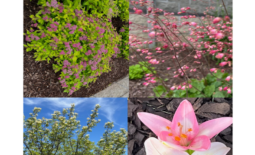Anne Frank Tree Planting Speech by Rabbi Hugenholtz
Anne Frank Tree speech 29th of April 2022
Rabbi Esther Hugenholtz
There is a story in the Talmud about a man and a tree. The Talmud is the Jewish people’s vast repository of rabbinic writings that interpret the Torah and that offers religious teachings, moral insights, legal rulings and folk tales.
This man’s name was Choni the Circle Maker. The Babylonian Talmud (Tractate Ta’anit 23a) recounts Choni journeying on the road, witnessing a man planting a carob tree sapling. Choni asked the man how long it would take the tree to mature. The man answered it would take seventy years, to which Choni replied, ‘are you certain that you will live another seventy years?’ The wise planter responded: “I found carob trees in the world; as my ancestors planted those for me, so I too plant these for my children.”
There are several reasons why I bring this pithy story to you today. First of all, because at this poignant moment of commemoration, I want to bring you the gift of living Judaism and teach you a snippet of our vibrant, resilient tradition that has nourished Anne Frank and us through eons and continents.
I am honored to stand here as a representative of Jewish culture, community and religious life in Iowa, a centennial’s worth of rich Jewish presence in our city.
I am delighted to stand here as a partner to the Jewish and non-Jewish institutions of our locality: Hillel, the University, the Obermann Jewish Studies courses, our civic partners and others.
Secondly, this is a story about a tree representing continuity, vision and hope: our ability to see beyond ourselves. Our Jewish values exhort us to lift ourselves above the immediacy of our own limited experience to embrace the larger perspective. Anne Frank was able to do this very thing with magnificence. She famously described the tree from the Annex; a place I know so well as a citizen of Amsterdam. Anne, my fellow Jewish Dutchwoman hinged her hopes on the branches of that tree; budded her dreams in its blossoms. Anne, the wise planter, knew that this tree would stand, seventy years after she was murdered by the Nazis.
In bittersweet synchronicity, the original chestnut tree outlived Anne. Today, we have wise planters planting it for the next generation; placed into its soil by our Jewish youth. The tree is Anne’s ‘eid’, her witness (and ours) to both the horrors and hopes of humanity.
The Jewish tradition greatly values trees. We compare our holy Torah to a Tree of Life. As the Book of Proverbs (3:17-18) describes ‘Etz chayim hi lamachazikim bah, deracheiyah darchei noam, v’chol netivoteiya shalom.’ – ‘She is a tree of life to those who hold fast to her, and her ways are ways of pleasantness; all her paths are those of peace.’
We sing these verses in the synagogue every time we return the Torah scroll to her ark; and we sing them in our hearts as we remember Anne Frank and her timeless gifts to humanity.
Anne’s writing was a path of peace. In our broken world, with escalating conflict, polarization, bigotry, racism and suffering, it is a message that we need to hear. Our Jewish community has been roiled by the rise of antisemitism in recent years: antisemitic incidents ranging from the repetition of dangerous stereotypes, to harassment, vandalism and outright murder in our houses of worship and beyond. I often find myself asking what Anne’s incisive commentary would be on our current moment. I believe she would have brought her moral courage. Anne powerfully and very Jewishly stated: “Where there’s hope, there’s life. It fills us with fresh courage and makes us strong again.”
Nefesh Mountain, a Jewish musical group, wrote a song about Anne Frank, called ‘Piece of the Sun.’ They poignantly sing: “Way back in 1943 / She lived inside her diary / In days underneath darkest skies / a burning ember inside / She writes to grief but not despair.”
Across the chasm of death and time, we uplift Anne’s voice; her refusal to despair—her stubborn hope. Anne’s vision bridges eternity and binds our hearts together.
We gather to honor the past; we plant to be guarantors of the future. We keep her imperishable flame burning; we will continue to tell her story.
As we would say in Hebrew and Dutch: ‘B’ruchah ha’b’a’ah b’Iowa’, ‘Welkom in Iowa, lieve Anne’ – Welcome to Iowa, dear Anne.
Picture courtesy of Janelle Jaskolka





